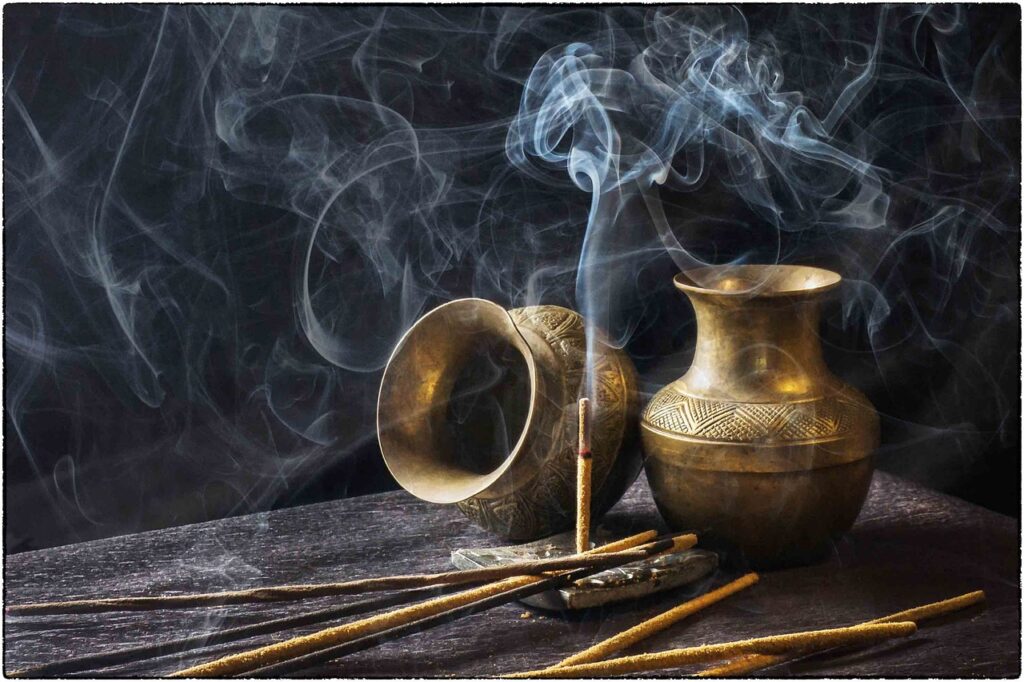
The use of symbols is of utmost importance in Hinduism, as it is an effective means of imparting the religion’s beliefs and teachings. These symbols, which are deeply rooted in Hindu philosophy, deities, cultural traditions, and teachings, are broadly categorized into mudras, which refer to hand gestures and body positioning, and murti, which refers to icons, statues, and drawings. Some of the widely recognized symbols in Hinduism include Om, the swastika, Trishula, lotus flower, lingam, Shanka, and lamp. The meaning of these symbols can vary depending on the followers’ country/region, culture and era. While some symbols, like Om, are unique to Hinduism, others, such as the swastika, have ties to other cultures and religions. During Hindu worship, murtis of various deities are used, and auspicious symbols are displayed in homes and temples to invite auspiciousness. The four Vedas, which are ancient Sanskrit texts, are the foundational texts of Hinduism (sanatan Dharma). They document the religion’s beliefs, rituals, and pastimes of the deities. While Hinduism varies across regions, cultures, and other factors, symbols, philosophies, and rituals are crucial in conveying the religion’s core beliefs and ideas. Many Hindu symbols have also been adopted into other religious traditions that came into contact with Hinduism. For example, the lotus is a commonly recognized symbol in both Hindu and Buddhist practices, and the trident has also been incorporated into religions such as Sikhism. Hindu worship involves various acts that utilize symbolism and visualization to create the appropriate mood and devotion into the practitioner.
In Hinduism, symbols hold great significance as they are believed to embody the divine when invoked with devotion and love. For instance, the murti of a deity is considered to be no different from the divine itself. As the Supreme Lord is the creator of all spiritual and material entities, it is believed that He takes on the form of a deity to accept service from His devotees. Many stories exist that illustrate deities responding to their devotees’ calls. For instance, the deity of Khira chora Gopinath in Remuna, Orissa, is said to have once stolen a pot of sweet rice and hidden it so that His beloved devotee Madhavendra Puri could later enjoy it.
Ten Important Hindu symbols
#1 Om (Aum)
Om or Aum is the most significant Hindu symbol, representing the primordial sound of creation and the original vibration of the universe. It consists of three syllables and represents the waking, dreaming, and deep sleep states of consciousness, with the fourth state being the awareness of one’s spiritual identity. The visual form of Om also symbolizes each of these states and represents enlightenment beyond material consciousness. Chanting Om aligns a person’s frequency with the universal frequency and can spiritualize their life. Om is considered to be the sound incarnation of the Supreme Personality of Godhead and is chanted at the beginning of many prayers and rituals.
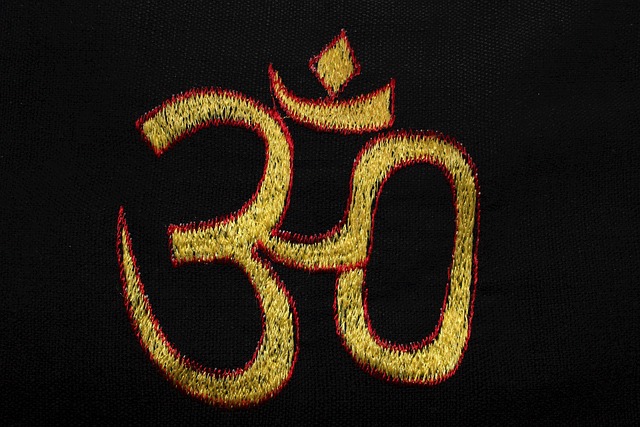
The Om symbol embodies different states of reality with each of its visual aspects. The large lower curve represents the waking state, where the mind is connected to the physical body and the world is perceived through the senses. The upper curve denotes the state of deep sleep, in which the mind is withdrawn from all activities. The middle curve signifies the dream state, where the subconscious is explored and consciousness is turned inwards. The dot symbolizes enlightenment, where a person recognizes the spiritual nature of creation and unites with the Absolute. The crescent represents maya, the illusion that binds the soul to the material world. Chanting Om can help transcend the three curves of material consciousness and reach enlightenment.
maharsinam bhrgur aham
giram asmy ekam aksaram
yajnanam japa-yajno ‘smi
sthavaranam himalayah
(Bhagavad Gita 10.25)
–
Of the great sages I (Krishna) am Bhrigu, Among all sound vibrations, I am the sacred syllable Om, Of all types of sacrifices, I am the chanting of the holy names [japa], and of immovable objects I am the Himalayas.
#2 Folded Hands in Prayer (Pranam)
Folding one’s hands and offering respect is a way of showing reverence for the sacred and dear. This gesture is often directed towards deities or saintly personalities and signifies a devotee’s acceptance of subservience.
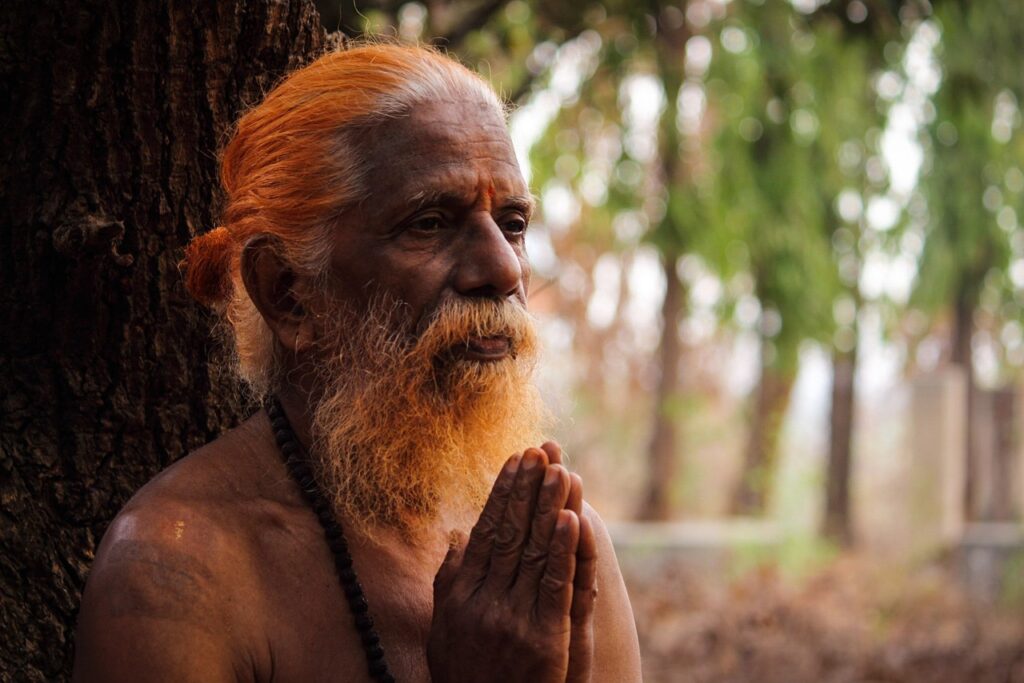
Humility is essential in Hinduism for receiving mercy or grace from the Lord. By showing respect to others and assuming a position of service to the Supreme, one’s heart is purified, false ego is eliminated, and one’s spiritual self is awakened. These practices rekindle the original desire of a devotee to establish a loving relationship with the Supreme.
#3 Lotus (Padma)
The lotus, a common symbol in Hinduism, represents both purity and transcendence. Despite growing in muddy waters, it remains untouched and beautiful. It is often depicted in the hands of various deities, such as Lord Vishnu. In order to truly follow the path of spirituality, one must maintain a pure conscience and remain absorbed in the service of the supreme Lord, regardless of one’s material conditions, economic status, social position, or occupation. One must always remember their eternal relationship with the Lord and find ways to engage in His service.

brahmany adhaya karmani
sangam tyaktva karoti yah
lipyate na sa papena
padma-patram ivambhasa
(Bhagavad Gita 5.10)
–
If one performs their duty without attachment and surrenders the results to the Supreme God, they will not be affected by sinful action. This is similar to how a lotus leaf remains untouched by water.
#4 Conch Shell (Shankha)
The conch shell, one of Vishnu’s four symbols, is used in arati. Vishnu’s conch, the ‘Panchjanya,’ is the most powerful among conch shells, originated from Samudra Manthan. The sound of the conch represents ‘Aum’ (Om) and is used as a trumpet in Hindu rituals. It marks the beginning of any good work and represents purity and new hope. The Shankha symbolizes both longevity and prosperity, and can be used as a symbol or musical instrument in Hindu rituals.
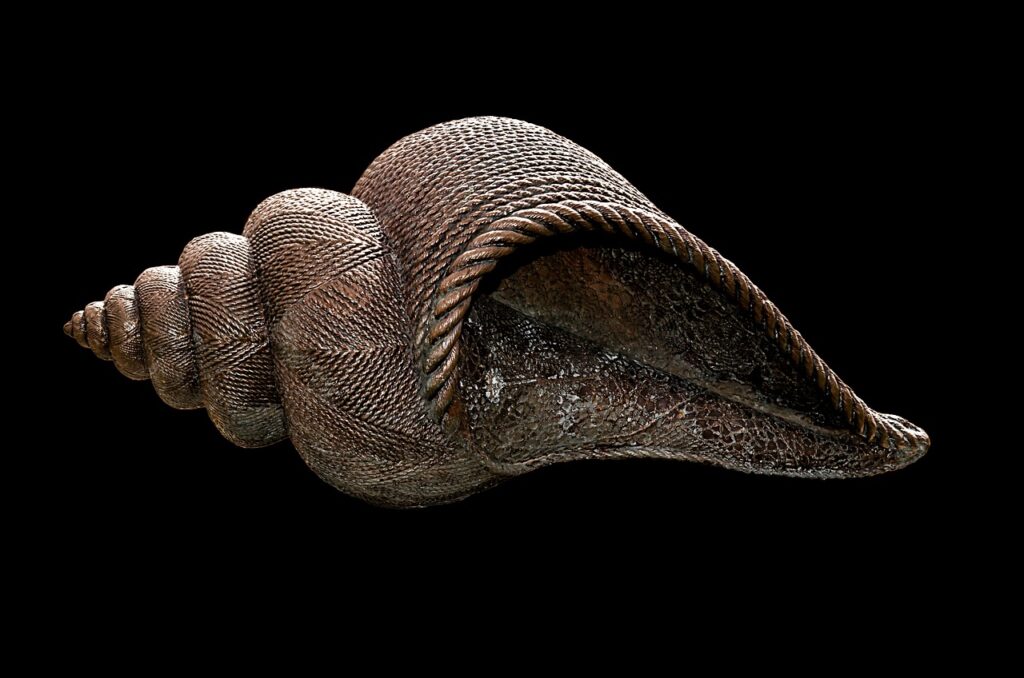
pancajanyam hrsikeso
devadattam dhananjayah
paundram dadhmau maha-sankham
bhima-karma vrkodarah
(Bhagavad Gita 1.15)
–
At that moment, Lord Krishna sounded His conch shell known as Pancajanya. Arjuna also blew his own conch shell named Devadatta, while Bhima, the mighty one with an insatiable appetite, sounded his thunderous conch shell known as Paundram.
#5 Swastika
The swastika, also known as the manji, is a solar sign of ancient origins believed to bring good fortune. The term swastika is derived from the Sanskrit words ‘su’ meaning good and ‘asti’ meaning to exist, symbolizing well-being, prosperity and good fortune.

The swastika is found in the Rig Veda, the oldest Hindu scripture, and is used in prayers. It can be seen as a representation of the four Vedas, the four goals of life, or the four seasons and directions. Swastikas can be found on various objects and are used in Hindu rituals and ceremonies, including on ceremonial pots and temple walls, and as pendants or inscriptions on account books.
#6 Trident (trishul)
The trishul-astra, a powerful weapon associated with Lord Shiva, is often carried by Shaivite sannyasis. It is said that this weapon, which functions as Shiva’s primary tool of destruction, has the ability to destroy the three worlds. According to mythology, the trishul-astra was used by Shiva to sever the original head of Ganesha. Its origins are described in the Vishnu Purana, where it is said to have been created with material from the Sun in association with Lord Surya.
Legend has it that Suryadev’s wife, Samjna, found her husband’s unbearable heat to be a source of unhappiness in their marriage. Her father, Vishwakarma, devised a plan to help her by apportioning off excess energy from Surya. The solar matter that fell to the earth was then fashioned into the deadly trishul-astra.

The trident or trishul-astra has become synonymous with Lord Shiva and is associated with various triad attributes. It is held in Shiva’s right hand and represents the three gunas. The three prongs symbolize the three shaktis of Shiva: iccha (will), jnana (knowledge), and kriya (action). Trident also stands for overcoming the three gunas – sattva (mode of goodness), rajas (mode of passion) and tamas (mode of ignorance). The points of the trishul also represent three aspects of Shiva: paramashiva, parashakti (paranada or shiva-tattva) and parabindu (parameshvara or shakti-tattva).
#7 Cow
Cow is a symbol of purity, motherhood and ahimsa (non-violence).
Namo brahmanya devaya
Go brahmana hitaya ca
Jagad dhitaya Krsnaya
Govindaya namo namah
(Vishnu Purana 1.19.65)
–
I offer my obeisances again and again to Lord Krishna, who is always worshiped by qualified brahmanas and is very dear to them. He is always concerned with the welfare of the cows, the brahmanas, and the whole world. I offer my repeated obeisances unto the Personality of Godhead, known as Krishna and Govinda.

The mantra cited in the Vishnu Purana is recited to worship and present offerings to Lord Krishna. It places significant emphasis on the safeguarding of cows and the brahmanas, who are representative of spiritual education. In ancient Vedic culture, cows were regarded as mothers and their milk sustained the entire society. The verse highlights the special affection that Krishna held for cows. In fact, the Bhagavad Gita quotes Lord Krishna in saying –
ayudhanam aham vajram
dhenunam asmi kamadhuk
prajanas casmi kandarpah
sarpanam asmi vasukih
(Bhagavad Gita 10.28)
–
Of weapons, I am the thunderbolt; among cows, I am Surabhi, the provider of plentiful milk. Of procreators, I am Kandarpa, the god of love, and of serpents, I am Vasuki, the chief.
Surabhi or Kamadhenu is a divine cow who is considered to be the mother of all the cows of this world. Surabhi is a ‘cow of plenty’ who could provide her owner with whatever he wanted.
#8 Kalasha
The utilization of a copper vessel known as the Kalash, distinguished by its wide base and narrow opening, is customary in various Hindu rituals, including the sacred fire offering. A coconut that is enveloped by mango leaves is placed inside this vessel, which serves as a vital element in several ceremonial practices. According to some beliefs, the Kalash is representative of the receptacle of the nectar of immortality that was produced during the samudra manthan or the churning of the milk ocean, hence embodying the notion of eternal life.
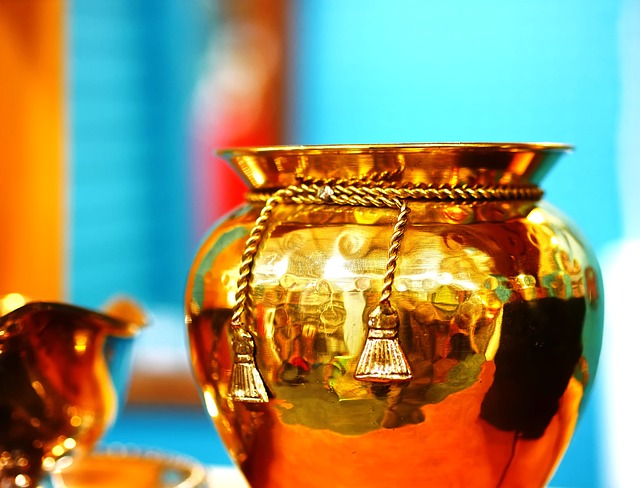
Others argue that Lord Vishnu, before the beginning of creation, laid on the milk ocean on His bed of Ananta sesha. A lotus sprouted from His navel, from which Brahma emerged and proceeded to create the planetary systems inspired by Vishnu. In this context, the water inside the Kalash symbolizes the primary water from which the Creator manifested creation. The Kalash is regarded as a symbol of abundance and wisdom.
#9 Feet (of guru or deity)
In the Hindu faith, touching the feet of a guru or deity is a highly meaningful expression of respect and veneration, referred to as “pranam” or “dandavat.” This involves bowing down and touching the person or deity’s feet with one’s head, signifying acknowledgement of the guru or deity’s superior spiritual understanding and connection to the divine. By doing so, one demonstrates humility, surrender, and gratitude towards the teacher or deity for their guidance and blessings.
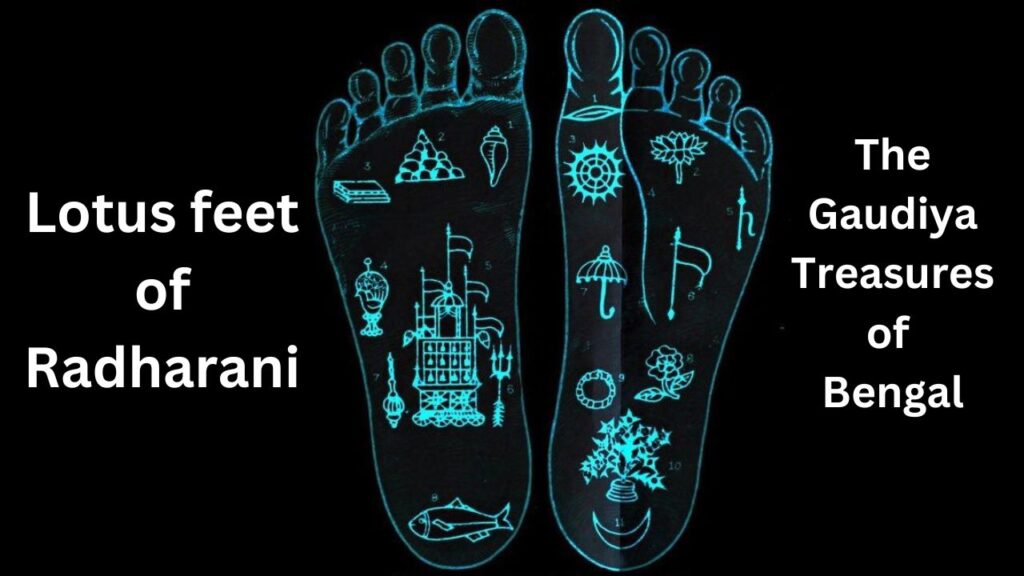
It is widely believed that through this act, one can receive spiritual energy and blessings. Seeking the blessings of a spiritual master or elders is considered crucial for spiritual growth, as it is believed that their blessings are essential to progress in one’s spiritual journey. Therefore, it is necessary to seek their mercy in order to nourish one’s spiritual life.
#10 Deep (Lamp) – symbol of Light
In Hinduism, it is common to find lamps placed near the altar or in temples. The lighting of a lamp is a customary way to commence various cultural and social events in India. This practice is considered sacred because the lamp symbolizes light. During an aarti, a small lamp is lit to honor a particular deity, and it represents prosperity, welfare, and positivity. Furthermore, lighting a lamp represents the elimination of darkness, ignorance, and negativity from one’s life.
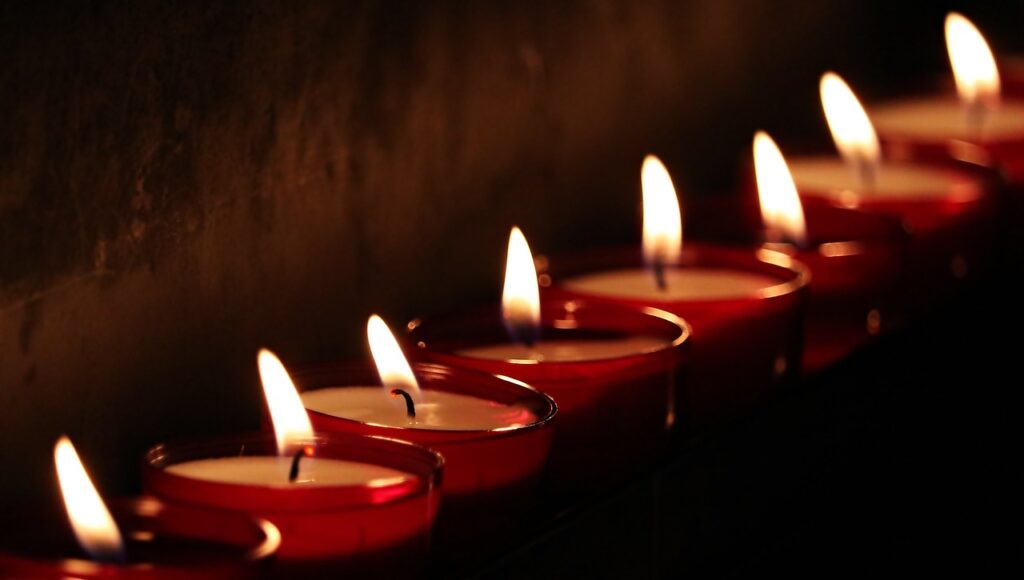
It is a symbolic representation of the inner light of consciousness and the spiritual light that leads one towards truth and knowledge. Lighting a lamp is also a way to invite the blessings of the deities and ancestors and to express gratitude and reverence towards the divine. Many Hindu festivals such as Diwali, and Dussehra involve lighting lamps in homes, temples, and public spaces to symbolize the victory of good over evil.